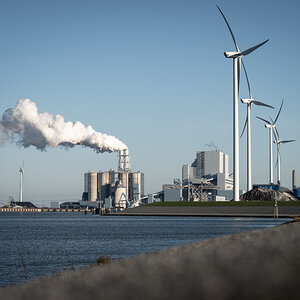2022 review: Climate philanthropy increased amid growing urgency

In 2022, multiple climate-related disasters swept across the globe: heatwaves and wildfires on multiple continents, floods in Pakistan and Nigeria, drought in the Horn of Africa, and a devastating Atlantic hurricane season, to name just a few. This past year also saw large philanthropic commitments in support of efforts to reduce greenhouse gas emissions, mitigate the impacts of climate change, and support climate justice by centering BIPOC (Black, Indigenous, and people of color), women, and people in the Global South. Despite the growing sense of urgency and calls for greater investment, however, research showed—and funders acknowledged—that the sector needs to do more to address the climate crisis.
A ClimateWorks Foundation report released in October found that in 2021, total grantmaking to address climate change grew 25 percent from 2020 levels, and it would appear that the momentum continued this year. Yet, based on a survey conducted between January and March 2022, a Center for Effective Philanthropy report funded by the William and Flora Hewlett Foundation found that even among foundations that explicitly fund climate initiatives, only 29 percent allocated at least 20 percent of their grant dollars to those efforts.
“Climate action is not happening fast enough, and our window is narrowing, so the pressure is on for all of us to raise ambition, accelerate action, and be more coordinated to get on track to achieve a 1.5°C future,” said ClimateWorks Foundation president and CEO Helen Mountford. “For philanthropy, this means getting more funds faster to the big opportunities to limit warming, while also ensuring people affected by climate impacts now can build resilience. Philanthropic investment in climate action has been rapidly increasing in the last few years, and I expect this momentum will continue to build. Funders will seek to work more collaboratively than ever and expand their reach to explore investments in new geographies, sectors, and intersectional approaches that leverage the power of collective action to improve people’s lives.”
“Climate action is not happening fast enough, and our window is narrowing, so the pressure is on for all of us to raise ambition, accelerate action, and be more coordinated to get on track to achieve a 1.5°C future. For philanthropy, this means getting more funds faster to the big opportunities to limit warming, while also ensuring people affected by climate impacts now can build resilience.
Recognizing the intersectionality of climate change impacts, some foundations pivoted or expanded their work to focus on climate funding. In July, the Rockefeller Foundation announced its commitment to making climate change central to all its work. In an open letter, foundation president Rajiv J. Shah acknowledged the irony of a foundation created with fossil fuel profits focusing on climate change mitigation but noted that the organization has always been dedicated to “leveraging the latest in science and technology to improve lives.”
“We have spent much of this year listening and learning—especially with women, youth, Indigenous people, and those whose voices are too often underrepresented in conversations about climate change, and who are most impacted by it,” said Elizabeth Yee, the foundation’s executive vice president for global programs, who is also spearheading the new climate strategy. “We’ve been thinking deeply about how the foundation’s strengths can accelerate action in these critical areas.”
In October, Ballmer Group, which is focused on advancing economic mobility for children and families, announced that it was expanding its grantmaking to include efforts to address climate change, given the implications of the climate crisis for those children and families. Its first round of grants totaling $217 million included $149 million to halt or reverse deforestation and $68 million to address carbon emissions and other climate issues.
As awareness of how communities of color and low-income communities are disproportionately affected by climate change grew alongside calls for racial equity and justice more broadly, climate justice became a focal point. As of late August, 36 foundations had joined the Donors of Color Network’s Climate Funders Justice Pledge—which commits signatories to transparency in climate-related funding and/or to directing at least 30 percent of that funding to BIPOC-led justice groups—including the Energy Foundation Climate Initiative, Solidaire Network, the Christensen Fund, and the ClimateWorks, Heising-Simons, and David and Lucile Packard foundations. In November, Amazon and the U.S. Agency for International Development launched a $56 million public-private partnership to address gender inequities in the climate finance ecosystem and ensure that female entrepreneurs have the resources they need to accelerate innovations in climate solutions.
A rise in the visibility of and support for conservation and land protection efforts by Indigenous peoples will be discussed elsewhere in this year-end series.
Among the areas that saw significant support this year was marine conservation, including a commitment announced in June of at least $1 billion from the Protecting Our Planet Challenge—a collaborative that includes Arcadia, the Bezos Earth Fund, Bloomberg Philanthropies, Bobolink, the International Conservation Fund of Canada, Re:wild, Nia Tero, the Rainforest Trust, and the Gordon and Betty Moore, Rob and Melani Walton, and Wyss foundations—to support the creation, expansion, and management of marine protected areas as well as Indigenous and locally governed marine and coastal areas. The Bezos Earth Fund also awarded grants totaling $50 million in support of marine conservation and research in the Pacific Ocean. In September, Bloomberg Philanthropies pledged $204 million to accelerate data-driven policy solutions and community involvement to protect coral reefs, stop illegal fishing, and safeguard marine ecosystems and biodiversity that are at risk from climate change.
Corporations and their founders also stepped up for conservation, with outdoor apparel company Patagonia announcing that founder Yvon Chouinard and his family had transferred ownership to a trust and a nonprofit organization and expect to pay out an annual dividend of roughly $100 million to help fight climate change and protect the planet. In Canada, Lululemon founder Chip Wilson’s Wilson 5 Foundation pledged C$100 million ($75.3 million) to the BC Parks Foundation, the largest private gift to date in the country’s conservation history.
In the area of climate science, two of the largest gifts for research institutes went to Harvard University: $200 million from Jean and Melanie Salata to create an interdisciplinary institute that will develop climate and environmental solutions and $350 million from Hansjörg Wyss in support of the Wyss Institute for Biologically Inspired Engineering. And, according to a study from the Rockefeller Foundation and Boston Consulting Group, more research is sorely needed: Investment in climate change mitigation is being hampered by a lack of data and data sharing, with only 16 percent of the $3.8 trillion in needed investments being met. Meanwhile, Climate TRACE, a nonprofit coalition of AI specialists, data scientists, researchers, and NGOs, found that global emissions from oil and gas production were as much as three times higher than reported, that 26 of the 50 largest sources of emissions worldwide are oil and gas fields, and that power plants represent more than half of the emissions.
Many of the major grants in support of efforts to reduce carbon emissions by transitioning to clean energy were announced during the United Nations Climate Change Conference (COP27), held in Egypt in November. At the conference, Ballmer Group, Bloomberg Philanthropies, Good Energies by Porticus, Growald Climate Fund, Three Cairns Group, and the Children’s Investment Fund, High Tide, Oak, and Sequoia Climate foundations committed to investing $500 million over the next three years to accelerate a just and equitable energy transition in low- and middle-income countries. Bloomberg Philanthropies also pledged $242 million in May to expand its energy transition efforts to 10 additional countries, announced an additional 15 countries in September, and introduced a two-pronged approach of working with national and local governments across the Global South to accelerate clean energy development while partnering with the Glasgow Financial Alliance for Net Zero to mobilize the flow of private capital to clean energy transition projects. In the United States, the foundation also launched an $85 million campaign to halt the rapid expansion of petrochemical and plastic pollution. One new area of clean energy, sustainable jet fuels, received a $50 million investment from Breakthrough Energy, a public-private partnership developed by Bill Gates and a coalition of private investors.
“COP27 focused on how those with resources must help developing nations—not only on their path to a clean energy future but to help them manage the loss and damages they already suffer—despite contributing the least to climate change,” said Antha N. Williams, who leads Bloomberg Philanthropies’ environment program. “It’s been a challenging year of multiple crises in public health, climate, and the economy. Fortunately, it has also shown the critical role we in philanthropy can play. Financing the clean energy transition is not only essential to mitigating climate change but is also a smart investment that provides energy access and security, strengthens economies, and protects public health.”
Amid warnings that none of the 2030 targets were on track to meet the goal of limiting global warming to 1.5°C, a flurry of public, private, and multilateral commitments were announced in the run-up to and during the climate conference. Three financing partners of the African Forest Landscape Restoration Initiative (AFR100) pledged to develop a $2 billion fund that will include $500 million in concessional finance and $1.5 billion in private investments in support of local restoration efforts across the continent. Thirteen philanthropies—the ClimateWorks, Packard, Ford, Children’s Investment Fund, Moore, Grantham, Klarman Family, and Hewlett foundations; the Climate and Land Use Alliance; Good Energies; Ballmer Group; Instituto Arapyaú; and Margaret A. Cargill Philanthropies—launched the Forests, People, Climate collaborative, which aims to end and reverse tropical deforestation, while delivering just and sustainable development.
Given that COP27 was held in Egypt, several commitments were focused on Africa and the Global South, which have contributed the least to climate change yet are disproportionately affected by its impacts. The Bill & Melinda Gates Foundation pledged $1.4 billion over four years to help smallholder farmers in sub-Saharan Africa and South Asia build resilience and food security through climate-smart agriculture projects, new applications of digital technologies, innovations for smallholder livestock farming, and support for women smallholder farmers. The Rockefeller Foundation awarded grants totaling more than $11 million in support of efforts to expand adoption of Indigenous and regenerative agriculture practices. The conference ended with national delegates agreeing to establish a “loss and damage fund” to compensate those countries that are the most vulnerable to climate disasters—a fund that will include more than $2 billion to restore degraded land in Africa. Despite such breakthroughs and increases in climate funding, some in the sector called for greater philanthropic leadership, including Laudes Foundation CEO Leslie Johnston.
Asked whether the momentum in climate philanthropy will continue in 2023, the Rockefeller Foundation’s Yee said, “I believe it has to—there’s simply no other choice. Less than 2 percent of total philanthropic giving was directed toward climate mitigation efforts in 2020, though that’s three times greater than where we were in 2015. We need to keep building on this positive trend, and we cannot let our guard down. Philanthropies can and should do more by leveraging their unique offerings, from concessional capital to bringing people together to collaborate and implement solutions.”
“This year’s sharp increase in climate funding is an encouraging sign that this issue is beginning to be treated with the urgency it deserves,” said Jonathan Pershing, director of the Hewlett Foundation’s environment program. “But we still have a long way to go in getting more funding on the table and increasing philanthropic collaboration so every dollar can yield the greatest results. Our advice to any philanthropy committed to creating better outcomes for future generations is to consider how to incorporate climate change into its giving and to connect with and collaborate with others already working in this space.”
Kyoko Uchida is features editor at Philanthropy News Digest.
(Photo credit: Getty Images/fudfoto)








